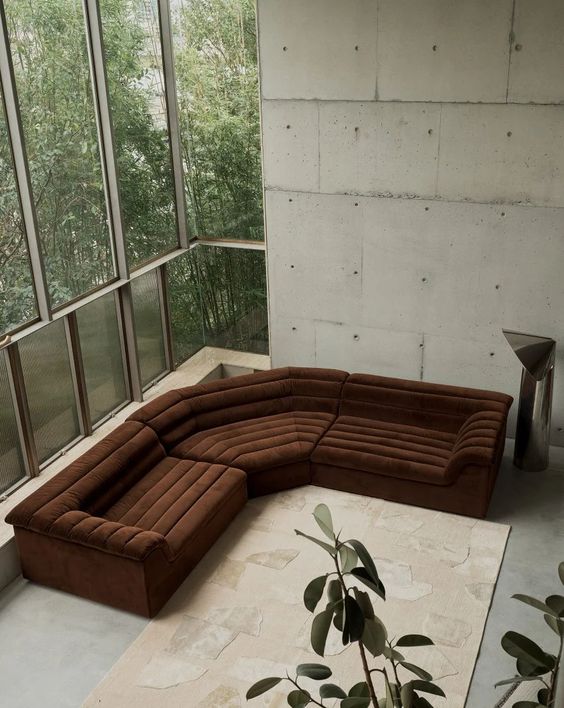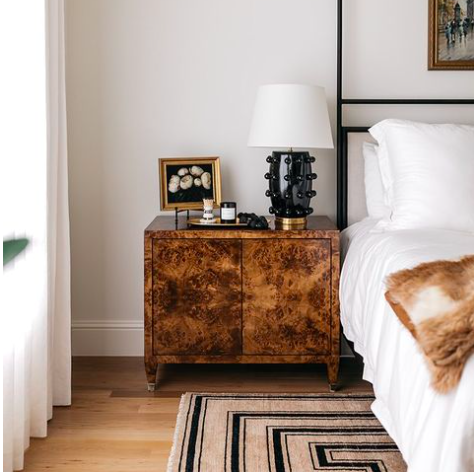
Source: Architectural Digest
70s House Design Remains Superior, Here are 18 Reasons Why
This post is all about 70s House Design. Here’s how to embrace the design decade.
In this article, we’ll prove to you why 70s design trends have stood the test of time, and continue to this day to be one of the most influential design eras ever.

Shag carpets, conversation pits and water beds are not the only design elements that come from the 70s house aesthetic. The design style of the time was fun and sexy with elements like earthy accents, gaudy statement pieces, and low and slouchy furniture that evokes a laid back elegance.
Some 50 years later, contemporary designers like Kelly Wearstler and musician turned designer, Lenny Kravitz, continue to reference 70s elements in their spaces and products. 1970’s design elements feel trendier than ever today, likely for the nostalgia and love of glam. Read on to view 70s style house trends that still feel modern today.
1. 70S STYLE TILES

70s style tiles are such a modern upgrade to your standard subway tiles. Squares of small, colored tiles in warm hues presents such a unique and classic alternative than other bathroom tiles. An entire tiled bathroom can create such a moody escape. Head to toe fully-tiled bathrooms look innately chic and well designed without too much effort. Paired with a moody color and the bathroom look feels elegant and effortless.
2. 70S HOUSE EXTERIOR

70s style house exteriors are iconic, and for good a reason. Images of 70s architecture may perhaps conjure up images of the Brady Bunch home – a ranch-style home with lots of geometric lines, a pitched roof with high ceilings and extra large windows. 70s house exteriors can have river rock accents, and exposed wood beams. As natural elements are critical to mid century design, you will often see lots of wood and river rock, and natural-looking landscaping throughout the exterior of the home. When renovating a 70s house exterior, consider using dark contrasting paint colors and a well groomed landscape to do the trick.
3. COLORFUL PATTERNS

Colorful patterns are a hallmark of 70s house aesthetics. Back in the day, you can find patterns on wall paper, carpets, upholstery and more. In today’s design landscape, colorful patterns in small doses can add a pop of interest in a home. Use colorful patterns in pillows, throw blankets, or in art to add some 70s flair to your space.
4. CANTILEVER CHAIRS

Cantilever chairs have had a major comeback in contemporary interior design. These chairs, whose legs are not typically supported by four legs, can be found made of chrome, and bent into an L shape. Some of these cantilever chairs like the Wassily by Marcel Bruer or these by Mies Van Der Rohe are famous designs and highly sought after for their modern form and 70s finishes. These chairs are the definition of laid-back design, and are also a marker of historical design appreciation that will surely impress.
5. 70S HOUSE DECOR

70s house decor is also iconic and continues to be used by designers as layering pieces throughout contemporary homes. 70s house decor like vintage ashtrays, ceramics, potted plants or macrame art are still extremely popular with designers. Be careful not to go overboard with 70’s decorative touches however. Adding these small 70s house decor touches help provide contrast in a home.
6. FIREPLACES

Fireplaces are a quintessential element to a 70s house. The architecture of the home during this era focused a lot on living spaces where people can entertain and socialize. Fireplaces in the middle of a room can be super cozy, and become a place for gathering. Fireplaces are an architecture feature that feels very mid century. 70’s fireplace trends were very unique. Conical chimeas or domed fireplaces made out of unique metals like copper were considered very stylish. If you have the luxury of renovating or building a home from the ground-up, consider adding a fireplace to center the room and to create a moody, cozy atmosphere around the hearth of the home.
7. CHROME ACCENTS

Move over brass, chrome is back! Whereas in most recent design history, it has been all about brass finishes, back in the 70s, polished chrome or cool toned metal finishes were all the rage. Furniture pieces like chairs, tables and lamps had chrome accents that made these pieces feel futuristic and modern. Chrome is a material known for its durability and shine, and thus became the metal of the future. In today’s design landscape, nothing is cooler than mastering the mix of metal tones. Try adding in chrome accents to add in 70s house aesthetics.
8. INDOOR PLANTS

One important characteristic of 1970’s houses is bringing natural elements into the home, and even bringing plants inside. During the 1970’s, indoor plants were a huge craze in home decorating. On the ground, placed on tables, or hanging from planters – indoor plants of all varieties were incredibly popular. Having greenery somewhere in your home is an important aspect to making your home feel more alive. Many indoor plant varieties are easy to care for, so you don’t have to have a green thumb to start!
9. LOW PROFILE SOFAS

Another huge trend of the 1970’s that continues to be popular is low profile furniture, particularly low profile sofas. Slouchy, low-slung sofas feel incredibly sexy and comfortable. Sometimes these sofas even lacked legs. Sofas like the trendy leather Togo sofa and the like have received their fair share of airtime on designer’s feeds recently. Vintage ones can be sourced on Chairish and modern dupes can be found on sites like Urban Outfitters.
10. BARWARE & BAR FURNITURE

While barware and cocktail paraphernalia may have begun in the 1950’s and 60’s, the 1970s perfected the art of entertaining with elaborately decorated bar carts and even sometimes, fully fixed wet bars. Bar carts and cabinets were adorned with colorful glassware, ice buckets and other cocktail essentials. Even the bars themselves were crafted from moody marbles that felt extremely glam. Up your bar cart game by taking note of 70s decor trends.
11. WOOD ON WOOD ACCENTS

70’s house decor was all about wood on wood accents – wood flooring, wood panels on walls, wood beams, and wood furniture. Wood accents are a timeless element that will always look great in a home. Use the wood to your advantage and keep these architectural details natural. The trick to layer wood on wood is to use different types and shades of woods throughout the home.
12. COLORFUL KITCHENS

Move over all-white kitchens, colorful kitchens are back! Colorful kitchens in all different hues like navy, pink, and even avocado green (a mid century favorite) have been cropping up all over in designer’s homes. Colorful kitchens are playful, joyous and feel so personal. The key to incorporating colorful kitchen trends is to play with color wisely – even pastels can pack a punch. Another more approachable way to add color to your kitchen is to choose colorful appliances like the popular Smeg fridge.
13. INDOOR/ OUTDOOR LIVING

Bringing the outdoors in is a large aspect of 70’s West coast ranch-style homes that separated home design styles from years before. Before the 70’s, the outdoors were separate and outdoor living was not prioritized as an essential part of the home. The decade of the 70s really focused on living with nature as opposed to apart from nature. In the 1970s, outdoor living was seen as the ultimate luxury, and it prioritized idyllic renovations to pools, patios, and to lush backyard landscaping.
14. RATTAN

Adding natural elements into your home like rattan is a 70’s element that is here to stay. Rattan accents add textural elements that instantly feel earthy and bohemian – all critical elements of 70’s design. Rattan or materials like wicker can be used in furniture, in decor, even in lighting fixtures. Consider adding in rattan elements into your space if your home feels void of texture.
15. 70S HOME ENTERTAINING DESIGN

The 70’s were all about entertaining. Larger ranch-style homes with open floor plans made the focus on entertaining easy. 70’s floor plan layouts focused on spacious living rooms with space for large modular sofas and grandiose fireplaces. One other trend that has come back with a vengeance is conversation pits. Conversation pits, like in the name, were an architectural feature in which the living room had a sunken pit where you could gather and host. Conversation pits were cozy and made entertaining feel intimate and special. When deciding on where to place furniture, consider the flow when entertaining to support gatherings.
16. BURL WOOD

Burl wood is a specific type of wood that occurs when a tree grows in irregular, unique patterns. It’s a rare type of wood that was extremely fashionable during the 1970s, but has become trendy yet again. Burl wood has reappeared in many contemporary furniture pieces, seen in places like CB2 and RH. However, you can find amazing antique burl wood pieces. The unique patterns provide a beautiful contrast to typical wood types, and makes for an instant statement piece in any home.
17. STONE ACCENTS

The 70’s were anything but understated. Gaudy, statement elements were all the rage, and elements like stone feel grand and ostentatious – in the best of ways. Stones like marble, travertine and onyx are luxurious, and can be used in home design in a myriad of ways. Stone slabs with colorful veining look gorgeous in kitchen and bathrooms, as well as in individual pieces like furniture, along with decor items servingware, catch all bowls and trays. Marble coffee tables and dining tables provide instant glam to a space.
18. CURVED FURNITURE

Lastly, furniture with curves and rounded edges had a big moment in the 1970’s that continues to be trendy today. These contemporary forms play into the organic modern trends that continue to persist today. Curved sofas, and other organic-formed furniture can be sourced either vintage or new. The curves found in these designs felt very different from other design eras and carved out a new design language that is still appreciated today.

In conclusion, the 1970’s house aesthetic involved many elements that still reign in popularity today. Luxurious details like wood, marble, lots of curves and chrome accents can be found in many contemporary interiors that have a deep rooted history in 70’s design. Consider looking at these cool 70’s home decor trends the next time you’re decorating your home.
Looking for more inspo from different decades? Check out this article on 80s house decor.
Some of the links in this article are affiliate links, meaning, at no additional cost to you, I will earn a commission if you click through and make a purchase. See our full disclaimer here.



